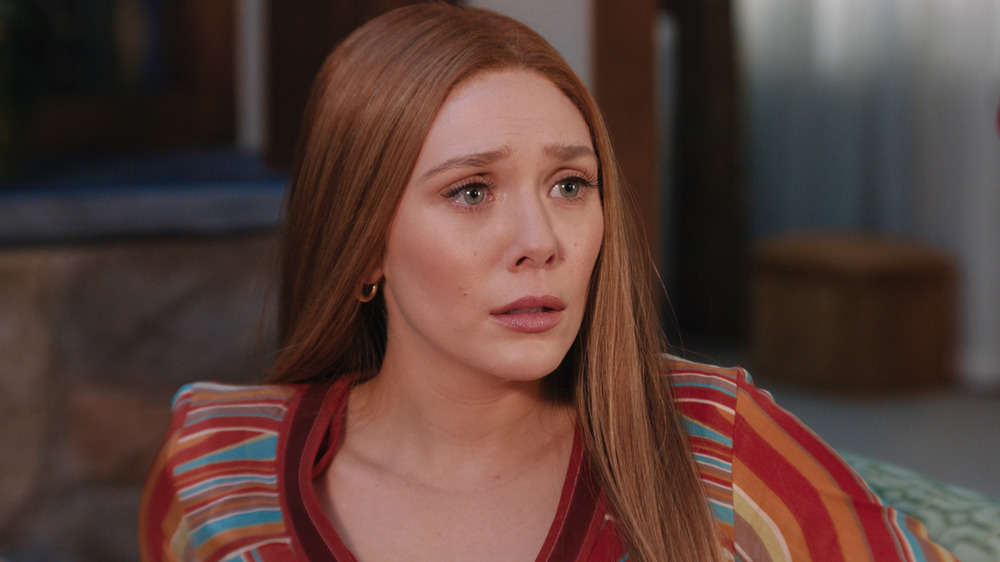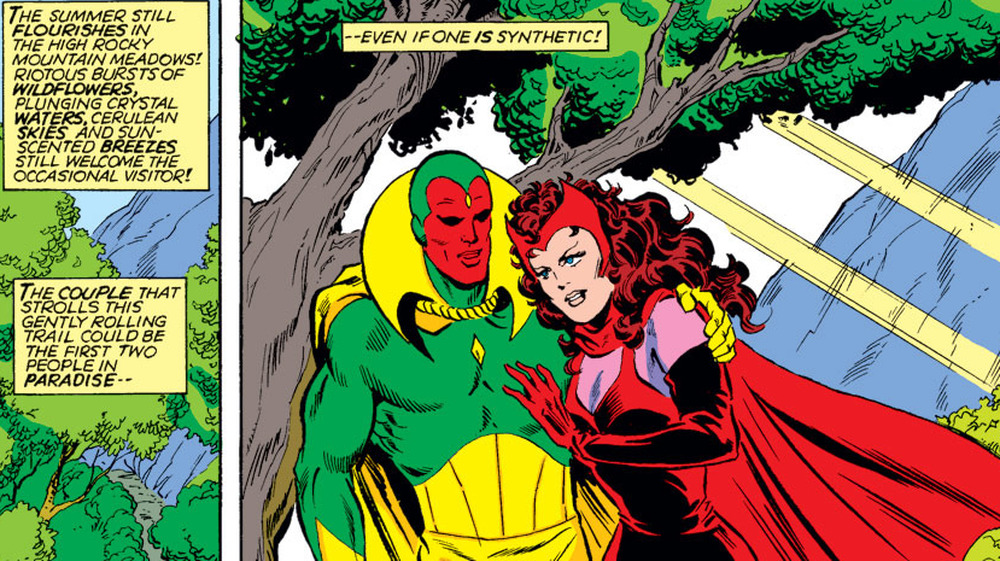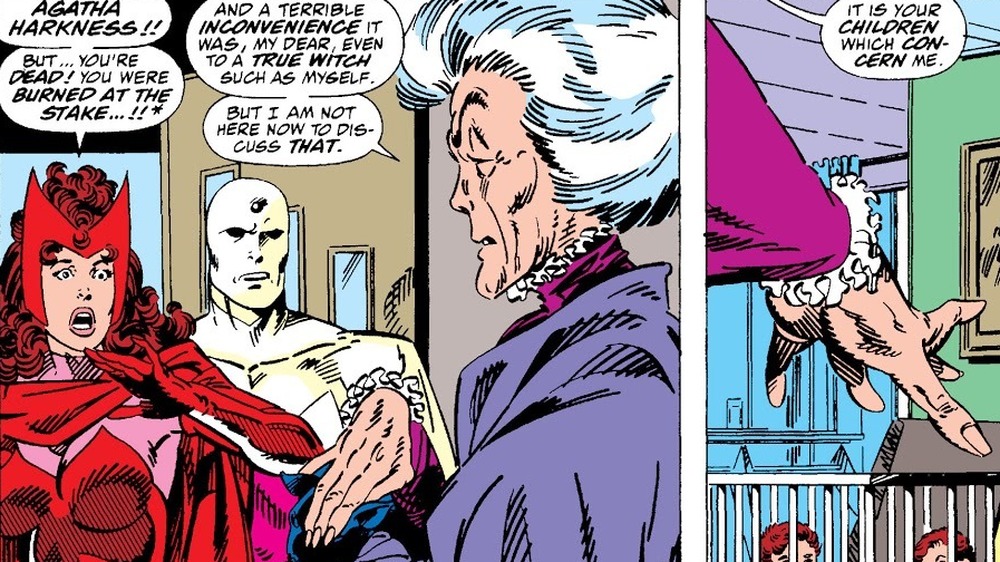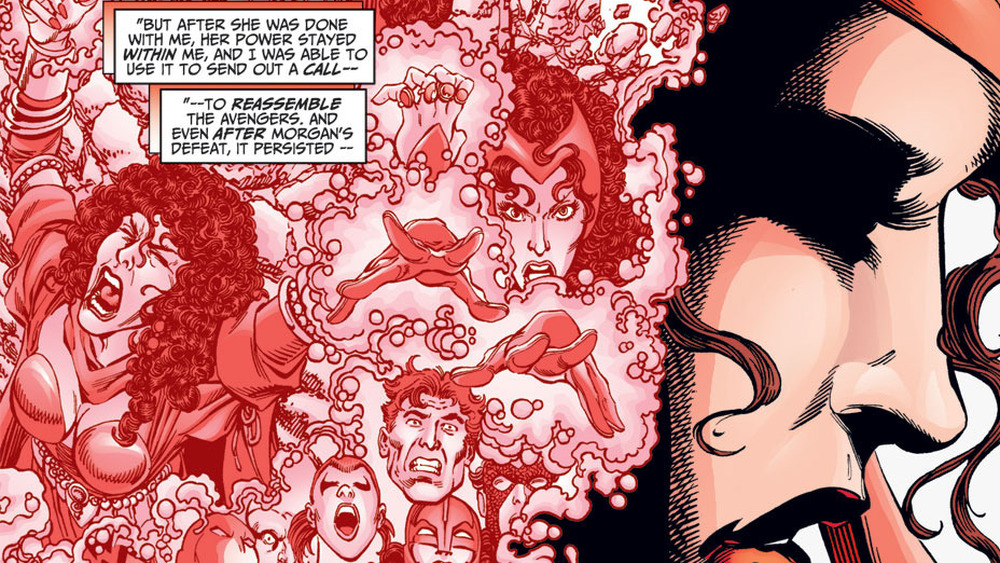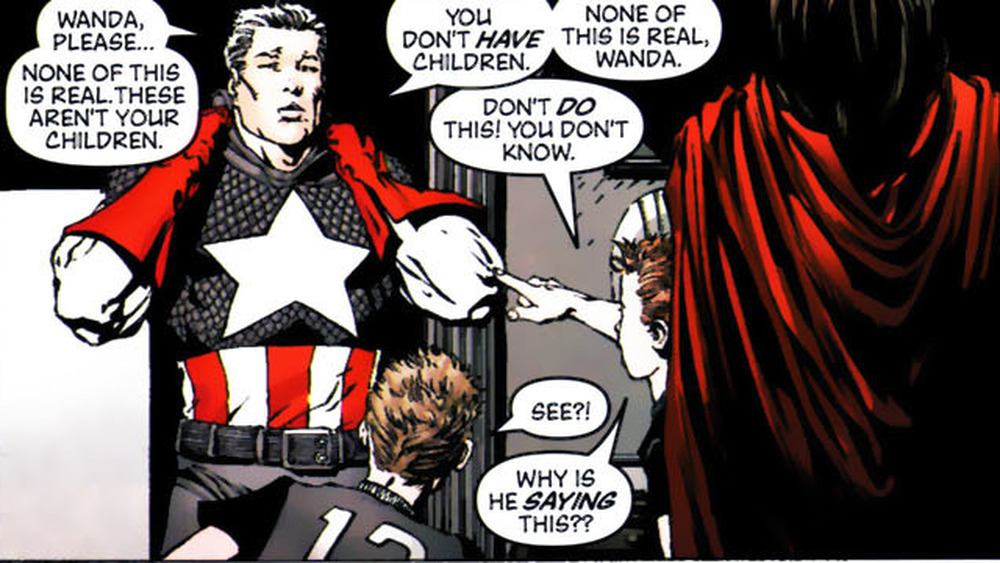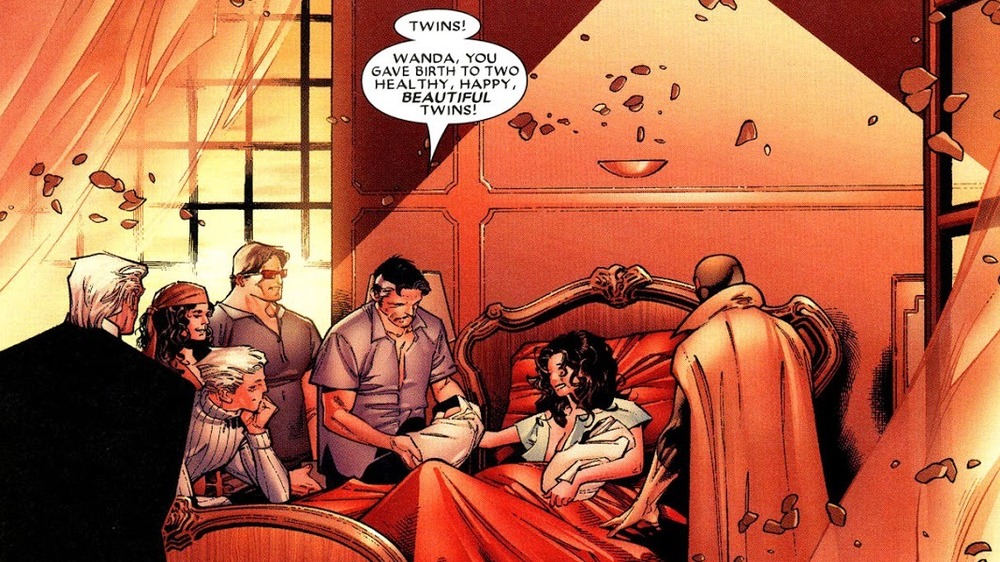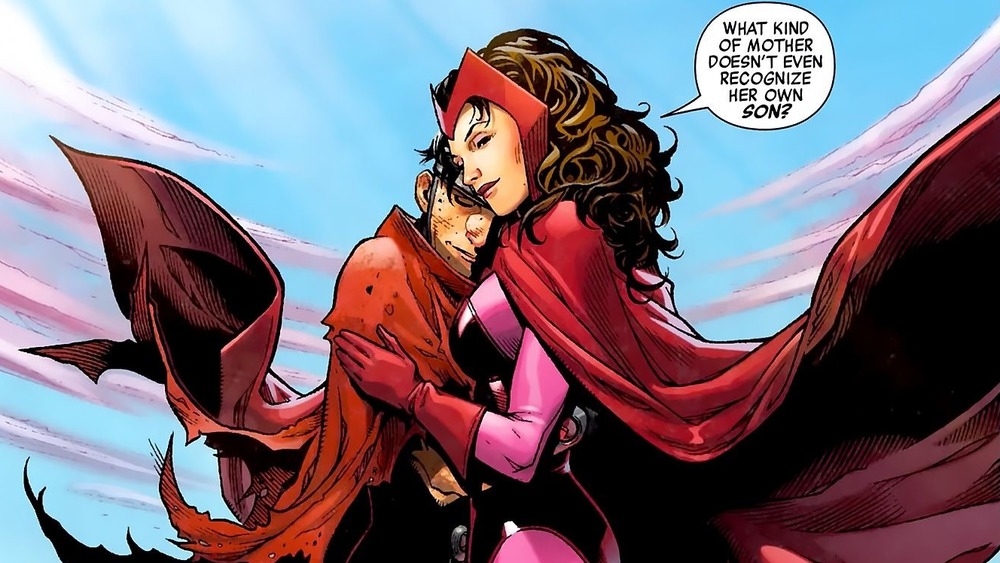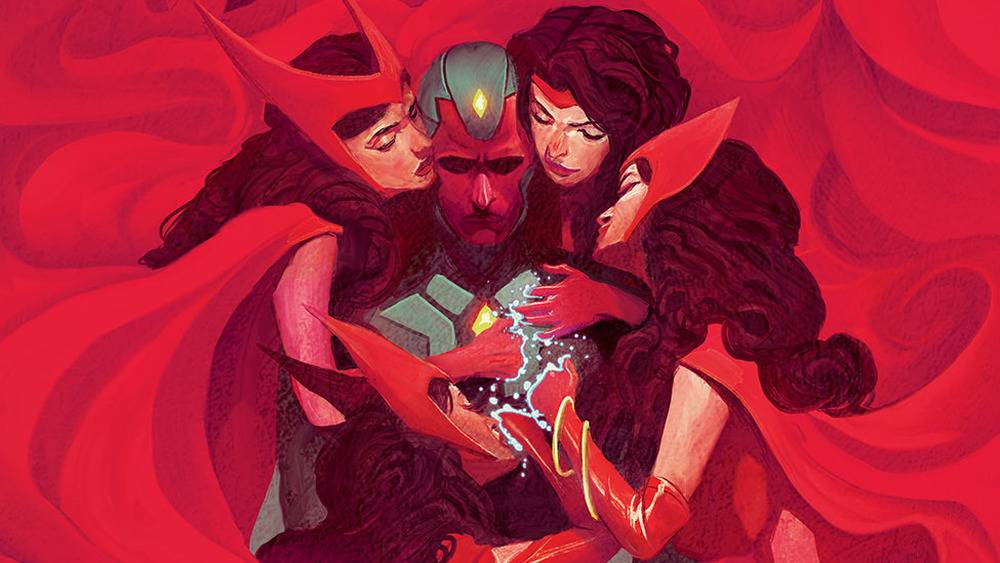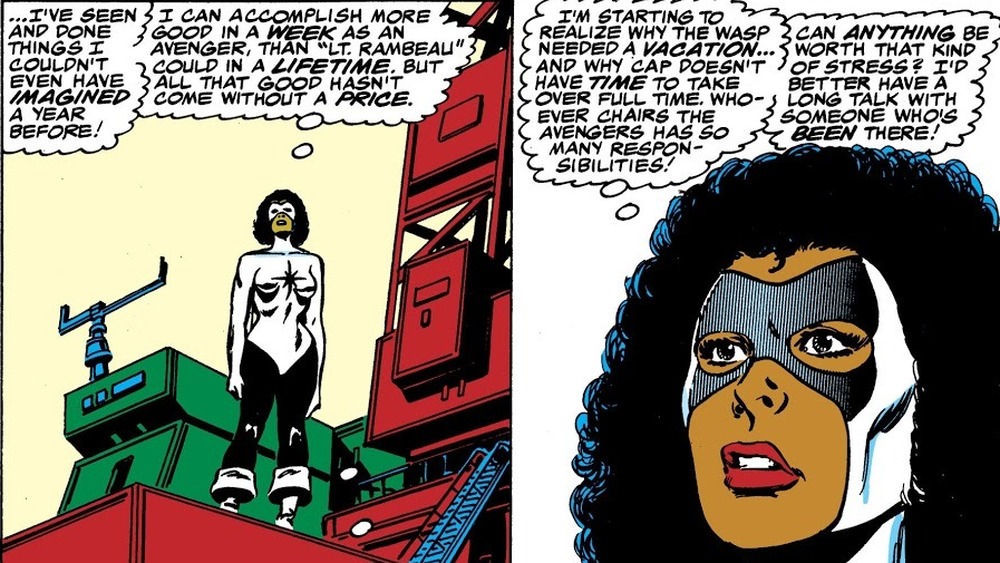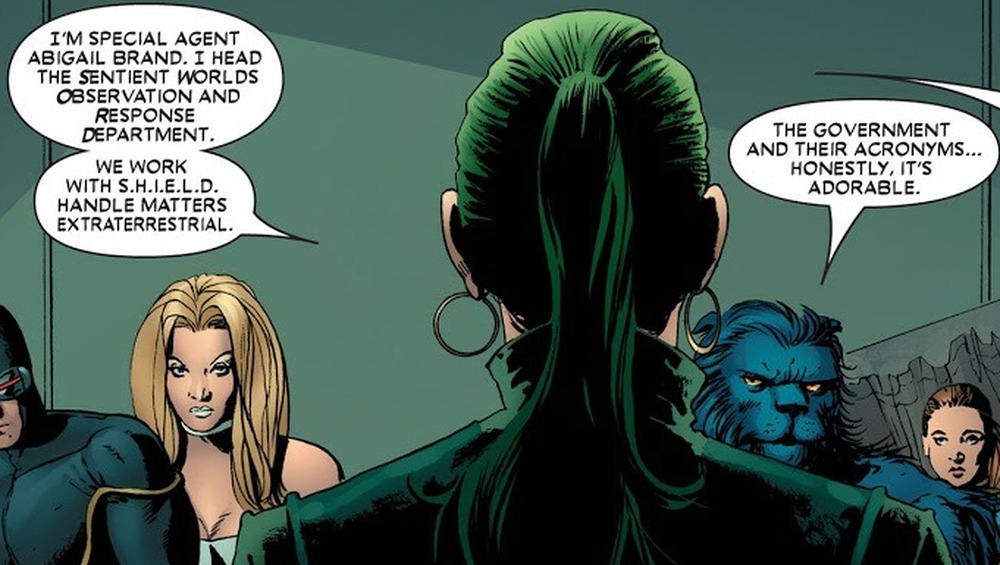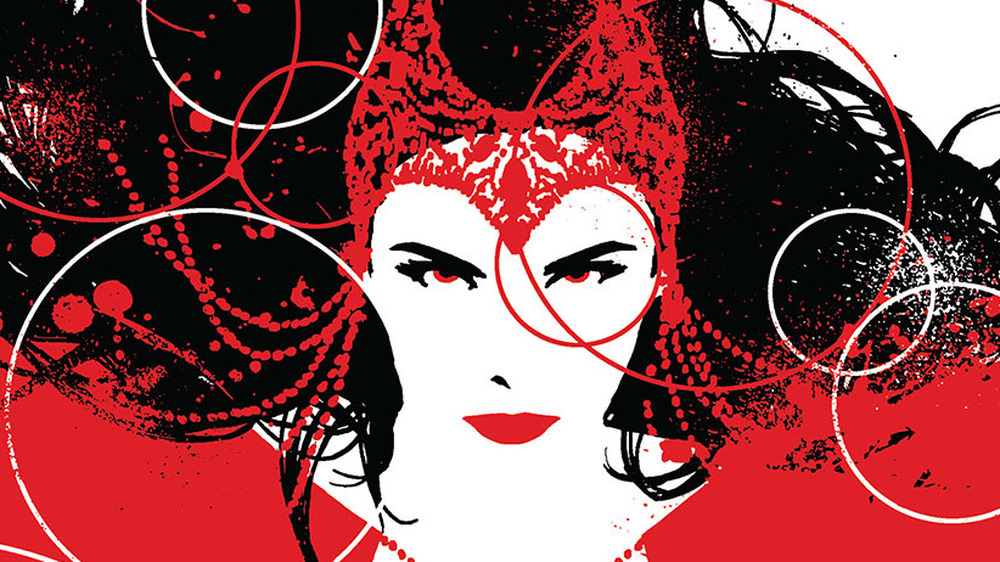Comics To Read If You Love WandaVision
WandaVision, the MCU's very first Disney+ series, is as dizzying as it is dazzling. A surreal look at one of Marvel's most enduring couples, it places Vision and Wanda Maximoff, a.k.a. the Scarlet Witch, within an artificial reality of mysterious origin, in which they live life as though they're on a wide variety of cheesy American sitcoms. Not all is well in Westview, New Jersey, however, no matter how many suburban talent shows and dinner parties the daffy duo pull off. Therein lies WandaVision's uneasy heart: Why, exactly, are these two Avengers playing house in simulacrums of Bewitched and The Brady Bunch's placid landscapes?
As it turns out, the answer to this question has some very deep roots in the Marvel Comics canon. Vision and the Scarlet Witch have a very long and tangled history in these pages: They've been married, separated, rebooted, brainwashed, evil, mind-controlled, and pretty much everything else in between. Despite the complexity of their history, however, it's remarkably easy for the comics newcomer to jump into their greatest stories. Eager to learn more about the comics that inspired WandaVision? Then you're in luck: These are the very best issues, series, and runs to read if you're dying to learn more about Westview's most unusual couple.
Vision and the Scarlet Witch
The 1980s saw two volumes of the Vision and the Scarlet Witch series, both of which are worth any WandaVision fan's time. The first volume, which premiered in 1982, sees our newlywed heroes making a whole-hearted attempt to live like normal people — or at least, as normal as a synthezoid and a witch can ever be. Their attempt to retire to suburban New Jersey is, of course, immediately disrupted by magic, mayhem, and Magneto. This four-issue series tackles a lot, despite its brevity, particularly spotlighting Wanda's complex parentage. That family drama combines wonderfully with old-fashioned superheroics, and is perfectly topped off by Wanda and Vision's irresistibly offbeat relationship.
The second volume of Vision and the Scarlet Witch hit newsstands in 1985. The intervening years put Wanda and Vision through the wringer, and so, more in love than ever, they decide to go back to Leonia, NJ. As ever, things get complicated, but their bond is at its most compelling in the 12 issues that make up this run. Wanda's pregnancy provides the series' backbone: She conceives her sons through magic in the third issue, and gives birth in the 12th. In between, fans are treated to the sight of Magneto attending a suburban Thanksgiving, Vision doing his best to look casual in blue jeans, and Scarlet Witch partying in New Orleans, clad in a maternity costume. It is, in short, adorable, and highly recommended for anyone who loves WandaVision's kooky portrayal of domestic bliss.
Darker than Scarlet
Once upon a time, a witch and a robot had two beautiful baby boys. Then along came a little series called Avengers West Coast and its 1989 "Darker Than Scarlet" arc, which takes a sledgehammer to Wanda and Vision's happiness. This storyline is, essentially, the beginning of every Scarlet Witch-centric comics event, storyline, and series of the last three decades. It's no stretch to say that what transpires in these pages is the reason WandaVision exists.
"Darker Than Scarlet" reveals Tommy and Billy, Wanda and Vision's beloved twin sons, to be magical constructs. As Agatha Harkness, Wanda's erstwhile mentor in witchcraft, explains, Wanda's desire for stable domesticity was so great, she unconsciously used two free-floating fragments of soul to conceive Tommy and Billy. Horrifically, the soul-shards she used belong to Mephisto, a top-tier demon and persistent Marvel baddie. Wanda is, naturally, traumatized. Though Agatha magically walls off the part of Wanda's consciousness which houses all memories of the boys, it doesn't stick. Soon after, Wanda plunges into outright villainy, and a baddie named Immortus is brought into the mix. The major takeaway here is twofold. First, Wanda is a toweringly powerful witch of bordering-on-divine proportions. Second, her subconscious desire for normalcy is so strong, it can assert itself through her powers without her consciously knowing about it. Sound like a certain MCU show you know of?
1998's Avengers #10
1998's Avengers #10 examines Wanda's origins with a fresh eye. Granted, many of the details covered in this issue have been retconned: Wanda's powers are here described as being rooted in chaos magic, she is identified as a mutant, and Magneto is treated as her biological father. Currently, none of that is true — and a whole lot of storylines have come and gone which paint her as significantly less in control of her powers. But still, this issue stands firm as a solid look at who Wanda is and what has shaped her.
While a raucous parade celebrating the Avengers goes on elsewhere, Wanda travels to visit Agatha Harkness, the wry old witch who tutored her in magic. Wanda's powers are troubling her, especially her newfound ability to bring Wonder Man back from the dead. Agatha agrees that this is concerning — but notably, she also believes that Wanda can learn to control her prodigious powers. As so many subsequent storylines have painted Wanda as being driven to destructive madness by her abilities, it's a wonderful change of pace to see her treated as unquestionably up to the task of harnessing them. Tragic reality-warping isn't going to stop being part of her story anytime soon, but it's also not the sole element of her story. Wanda is at her best when she is treated as being capable of growing beyond her worst days — something this issue, and the MCU, knows well.
Avengers Disassembled
2004's "Avengers Disassembled" event begins with the arrival of Jack of Hearts at the Avengers' door. This is strange, as he just died. It gets a whole lot stranger when his undead corpse explodes, taking out Ant-Man. Things go from bad to worse: Tony Stark becomes inexplicably drunk while delivering a speech at the UN, Vision crashes a Quinjet into Avengers Mansion, and Hawkeye is killed in a Kree attack. The Avengers go into crisis mode, looking for any and all answers as to what, exactly, is tearing their team apart on so many fronts.
Finally, Doctor Strange appears. Wanda, he reveals, is to blame for these multitudinous tragedies. The loss of her twin sons (who were, in fact, magical constructs Wanda willed into being) has been lurking within her like a ticking time bomb, finally set off by an innocuous comment from the Wasp. The chaos of the past few days is all down to her lashing out in rage and madness on a scale only someone with reality-warping powers could pull off. This storyline casts Wanda and her powers in a terrifying light, and fundamentally altered her place in the Marvel universe. It also led to House of M, a storyline that might be the most climactic in Wanda's entire history. Though many of "Avengers Disassembled's" details been retconned over the years, its shocking events haven't been forgotten — and neither has the way it framed Wanda as a rogue warhead, capable of untold destruction.
House of M
2005's House of M storyline hinges upon the nigh-godlike nature of Wanda's powers, and, specifically, what might be her most dramatic use of them. This tale unfolds in the aftermath of the "Avengers Disassembled" event, which sees Wanda fly into a murderous rage upon being reminded of her lost twin sons. After she is taken down by Doctor Strange, the Marvel universe's top-tier superheroes debate what to do with her. But before they can take action, Wanda remakes the world entirely. Our heroes wake up in a reality ruled by mutants, with Magneto and his "House of M" at the very top of the heap.
Eventually, our heroes realize the truth, and a battle ensues. At its apex, Scarlet Witch appears. She rages against Magneto for dooming her and Pietro to dysfunction for the sake of his mutant ideals. Tearfully clutching her brother's battered body, she utters an immortal line: "No more mutants." When our heroes return to their reality, they find that the vast majority of the world's mutants have become everyday humans.
Like "Avengers Disassembled," this storyline treats Wanda as a terrifyingly potent force, but there's a notably tragic air to these proceedings. Her actions are shocking, but it's hard not to sympathize with her as she lashes out at Magneto for his exploitation and cruelty. Wanda has tried, once more, to fix her own broken heart and, by extension, what she perceives to be a broken world. The consequences are unforgettable.
Young Avengers
Billy and Tommy, Wanda and Vision's twin sons, have a long, strange history in the Marvel universe. Sometimes they're real, sometimes they're illusions, sometimes they're fragments of uber-demon Mephisto's soul. The 2000s, however, saw them come into their own as Billy Kaplan and Tommy Shepherd, a.k.a. Wiccan and Speed, stalwart members of the Young Avengers. They're not exactly the sons Wanda gave birth to — basically, they're reincarnations of those kids, born to other families. The exact nature of their connection is a little fuzzy, but the fact that it's meaningful is clear: Billy has Wanda-ish reality-warping magic that borders on godhood, while Tommy has Pietro's white hair and super speed.
WandaVision could very well be setting up Tommy and Billy for their MCU entrance, and there's no better way to get acquainted with them than checking out their time as members of the Young Avengers. 2005's Young Avengers series is a great introduction to both characters, while 2010's Avengers: The Children's Crusade sees them confront their nature as reincarnated pseudo-children head-on. 2013's Young Avengers run takes things in a slightly different direction — a young Loki is in the mix, intra-dimensional shenanigans take place, and Billy saves the world by kissing his boyfriend, Hulkling — but it's one well worth exploring. Is everything having to do with Tommy and Billy a little confusing? Yes. Is it entertaining? Also yes. So it goes in comics, especially when the Scarlet Witch and Vision are involved.
Vision
2015's Vision series hit the comics landscape like an asteroid. The first issue introduces Vision's new home in the DC suburbs, which he has filled with his similarly new wife, daughter, and son. They are all synthezoids: Their hair is green, their skin is red, and they boast all the fabulous abilities the man of the house possesses. Yet they are living as a normal American family, beholden to homework, dishes, and deadlines. The kids, Viv and Vin, deal with school; Virginia, their mother, attends parent-teacher conferences; and Vision heads off to work in the morning — though of course, that work often involves fighting skyscraper-tall monsters.
Over the course of 12 tightly written issues, Vision unravels why Vision has thrown himself into pursuing a normalcy so at odds with his own nature — and the ways in which it was a doomed project from the start. This isn't a spoiler: The first issue's narration introduces a neighbor couple, then immediately describes the deaths awaiting them at the hands of Vision's family. In declaring its intentions so early, Vision allows itself to explore the heart-wrenching complexity of Vision's journey with a unique level of introspection. His relationship with Wanda might not be spotlighted here, but the shadow it casts over the entire affair is long, and explored in especially affecting detail in the series' seventh issue. In exploring the impossibility of Vision's quest to be normal, Vision takes the character to dizzying new heights of humanity.
Avengers #279
Monica Rambeau has gone by many names over the years — and we're not talking about her time as "Geraldine." The energy-warping powerhouse has been called Spectrum, Photon, Pulsar, and Captain Marvel. Through it all, she has been defined by her tenacity, courage, and, above all, her top-shelf leadership skills.
The 1980s were good to Monica. 1983 saw her join the Avengers, while 1989 brought Captain Marvel, Monica's very first solo series, to the stands. But as far as introductions to the character, 1987's Avengers #279 is where it's at. The Wasp has stepped down as chairwoman of the Avengers, and to Monica's surprise, Captain America nominates her to lead the team next. Though she's flattered, she's unsure if she's ready to accept such a huge responsibility. As she ruminates over her decision, she visits her parents (that's right — she's got two of them in the comics), recalls the day she got her powers, helps Cap save kids trapped in a cave, and visits colleagues in the hospital. Basically, it covers everything that makes her who she is: The love instilled in her by her family, her disinterest in suffering fools, and her deep sense of compassion. In the end, she accepts the position, and goes on to lead the Avengers with skill, empathy, and perseverance. Might we see her do the same in the MCU? Only time will tell — but it sure seems like WandaVision is setting her up for big things.
Astonishing X-Men
Marvel sure does love their shadowy governmental organizations, don't they? S.W.O.R.D., introduced to the MCU via WandaVision, is only one of many, but it's definitely one of the coolest. S.W.O.R.D. made its debut in 2004's Astonishing X-Men #3, via Abigail Brand, the organization's leader, appearing the shadows behind Nick Fury. S.W.O.R.D.'s acronym stands for slightly different words than it does in the MCU: Here, they're the Sentient World Observation and Response Department, while on WandaVision, they're the Sentient Weapon Observation and Response Division.
Basically, S.W.O.R.D. is an intelligence agency that deals with extraterrestrial threats. Like S.H.I.E.L.D., they keep their own counsel, and like Fury, Brand is a gruff, no-nonsense leader who cares a whole lot more about getting the job done than making sure she doesn't hurt anyone's feelings. (She even has a unique visual signifier in her green hair, which, like Fury's eyepatch, has a surprising place in her backstory.) Though this run doesn't feature Wanda or Vision, it's a great look at the sort of space-centric storytelling that seems likely to define the MCU's future, and serves as a solid introduction to the governmental apparatus that acts as the Earth's front line of defense. Plus, it's an enormous amount of fun, and totally accessible to even the most uninitiated readers. Now who's ready to put money on whether a Marvel's Agents of S.W.O.R.D. series will be coming to Disney+ any time soon?
Scarlet Witch
2015's Scarlet Witch had a lot to tackle. Few Marvel characters have a more convoluted backstory than Wanda, to say nothing of the turmoil her powers have caused. Writer James Robinson, who worked with a plethora of artists on this visually inventive series, takes an intriguing and unique approach to this state of affairs: He confronts Wanda with a magical landscape as broken as she herself feels. In so doing, Scarlet Witch faces the character's dysfunction head-on, championing her as someone of courage and cleverness, even as it reckons with her darkest hours.
Wanda begins in New York City, where she realizes witchcraft itself has become sick. She proceeds to travel across the world in her efforts to heal her craft, Agatha Harkness' sarcastic ghost at her side. Scarlet Witch's greatest triumph is that it takes Wanda seriously: She isn't treated as a dangerous madwoman, a fragile waif, or a miserable penitent, but as a woman attempting to forge a future for herself in a strange and often contradictory universe. Elements of her backstory which have historically been treated as exotic window dressing get real, meaningful focus here, especially her Romani roots, which she explores in Serbia. This series takes it as a given that Wanda is a multifaceted creature, and, as a result, reframes her entire history as one of heroic struggle, rather than tragic instability. In short, it treats her like an honest-to-goodness superhero — and somehow, it makes it look easy.
